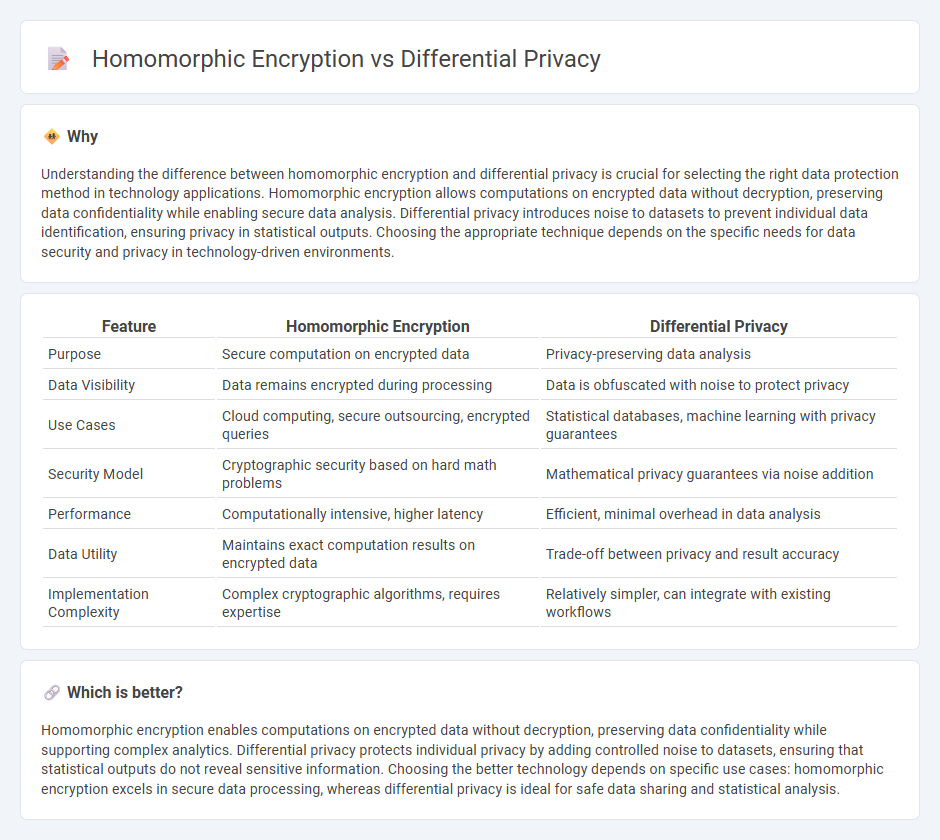
Homomorphic encryption enables computations on encrypted data without decrypting it, preserving data confidentiality during processing. Differential privacy adds noise to datasets to protect individual privacy while allowing statistical analysis. Explore the key differences and applications of homomorphic encryption and differential privacy to enhance data security.
Why it is important
Understanding the difference between homomorphic encryption and differential privacy is crucial for selecting the right data protection method in technology applications. Homomorphic encryption allows computations on encrypted data without decryption, preserving data confidentiality while enabling secure data analysis. Differential privacy introduces noise to datasets to prevent individual data identification, ensuring privacy in statistical outputs. Choosing the appropriate technique depends on the specific needs for data security and privacy in technology-driven environments.
Comparison Table
| Feature | Homomorphic Encryption | Differential Privacy |
|---|---|---|
| Purpose | Secure computation on encrypted data | Privacy-preserving data analysis |
| Data Visibility | Data remains encrypted during processing | Data is obfuscated with noise to protect privacy |
| Use Cases | Cloud computing, secure outsourcing, encrypted queries | Statistical databases, machine learning with privacy guarantees |
| Security Model | Cryptographic security based on hard math problems | Mathematical privacy guarantees via noise addition |
| Performance | Computationally intensive, higher latency | Efficient, minimal overhead in data analysis |
| Data Utility | Maintains exact computation results on encrypted data | Trade-off between privacy and result accuracy |
| Implementation Complexity | Complex cryptographic algorithms, requires expertise | Relatively simpler, can integrate with existing workflows |
Which is better?
Homomorphic encryption enables computations on encrypted data without decryption, preserving data confidentiality while supporting complex analytics. Differential privacy protects individual privacy by adding controlled noise to datasets, ensuring that statistical outputs do not reveal sensitive information. Choosing the better technology depends on specific use cases: homomorphic encryption excels in secure data processing, whereas differential privacy is ideal for safe data sharing and statistical analysis.
Connection
Homomorphic encryption and differential privacy are connected through their shared goal of enhancing data security and privacy in computational processes. Homomorphic encryption allows computations on encrypted data without revealing sensitive information, while differential privacy introduces noise to data outputs to prevent individual data identification. Together, these technologies enable secure data analysis and machine learning on private datasets by balancing data utility and confidentiality.
Key Terms
Data confidentiality
Differential privacy ensures data confidentiality by adding calibrated noise to datasets, protecting individual privacy while allowing useful statistical analysis. Homomorphic encryption enables computations directly on encrypted data, ensuring data remains confidential throughout processing without decryption. Explore further to understand how these technologies safeguard sensitive information in diverse applications.
Privacy-preserving computation
Differential privacy ensures privacy by adding statistical noise to data, preventing individual information from being identified while enabling aggregate analysis. Homomorphic encryption allows computations to be performed directly on encrypted data without decryption, preserving data confidentiality throughout the process. Explore the distinct advantages and applications of these privacy-preserving computation techniques to enhance data security.
Noise addition vs. encrypted computation
Differential privacy enhances data privacy by adding calibrated noise to datasets, ensuring individual data points remain indistinguishable while maintaining overall data utility. Homomorphic encryption allows computations to be directly performed on encrypted data without decryption, preserving data confidentiality throughout processing. Explore the specific applications and advantages of noise addition versus encrypted computation to better understand each technique's role in data security.
Source and External Links
What Is Differential Privacy? - Differential privacy is a mathematical approach that protects individual privacy in data sets by introducing random noise to data analyses, ensuring adversaries cannot identify individuals even when combining multiple data sources.
Differential privacy - Wikipedia - Differential privacy is a rigorous mathematical framework that enables statistical data sharing by adding calibrated noise to limit private information disclosure about individuals in a dataset, commonly used by governments and companies for privacy-preserving data analysis.
Differential Privacy - Apple - Apple implements differential privacy by privatizing user data locally on devices with noise addition before transmission, controlling data contributions through a privacy budget to prevent user re-identification while analyzing aggregate statistics securely.
 dowidth.com
dowidth.com